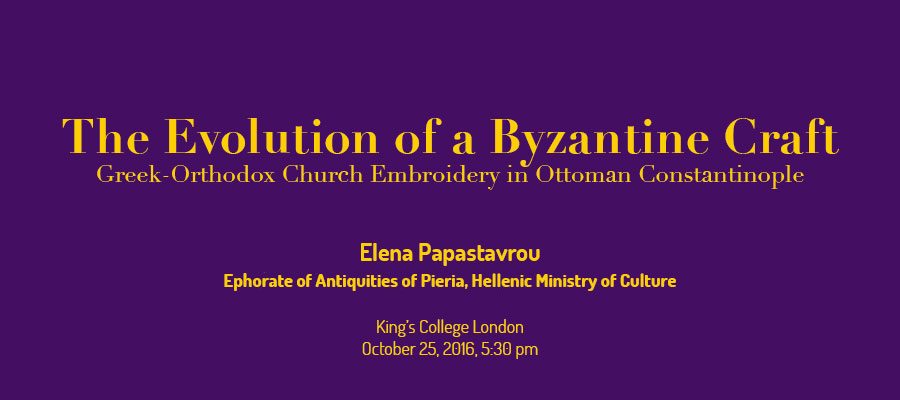The Evolution of a Byzantine Craft: Greek-Orthodox Church Embroidery in Ottoman Constantinople, lecture by Elena Papastavrou (Ephorate of Antiquities of Pieria, Hellenic Ministry of Culture), King’s College London, October 25, 2016, 5:30 pm
The main body of Greek Orthodox Church embroideries produced in Ottoman Constantinople examined in this study belongs to the Byzantine and Christian Museum (Athens). They date between the 17th and the 19th century and their provenance is mainly from Greece and Asia Minor. My objective is to present the various stages of development of ecclesiastical embroidery in Constantinople after 1453, showing some special technical features, discussing the artistic tendencies and revealing information about the organization of the various workshops. Furthermore, I try to illuminate in an interdisciplinary way to what extend late Byzantine embroidery technique and iconography evolved and continued to live on in the Constantinopolitan School of embroidery during the Ottoman period.
Elena Papastavrou studied Byzantine art history at the Universities of Athens and Paris I (Sorbonne-Panthéon), with an interest in painting and the minor arts. Her two doctoral dissertations, supervised by Tania Velmans, discuss the artistic exchanges between Byzantine and Western European religious painting in the late Middle Ages. Apart from her monograph on the iconography of the Annunciation, she has published extensively on Byzantine and Western European, and especially Venetian, painting and minor arts. For twenty years she was Senior Curator for Textiles, Minor Arts and Paintings on canvas at the Byzantine and Christian Museum (Athens), participating in many Greek and international exhibitions, including Byzantium: an Ecumenical Empire, in which she worked as lead curator. Her current research focuses on the Constantinopolitan School of ecclesiastical embroidery.
